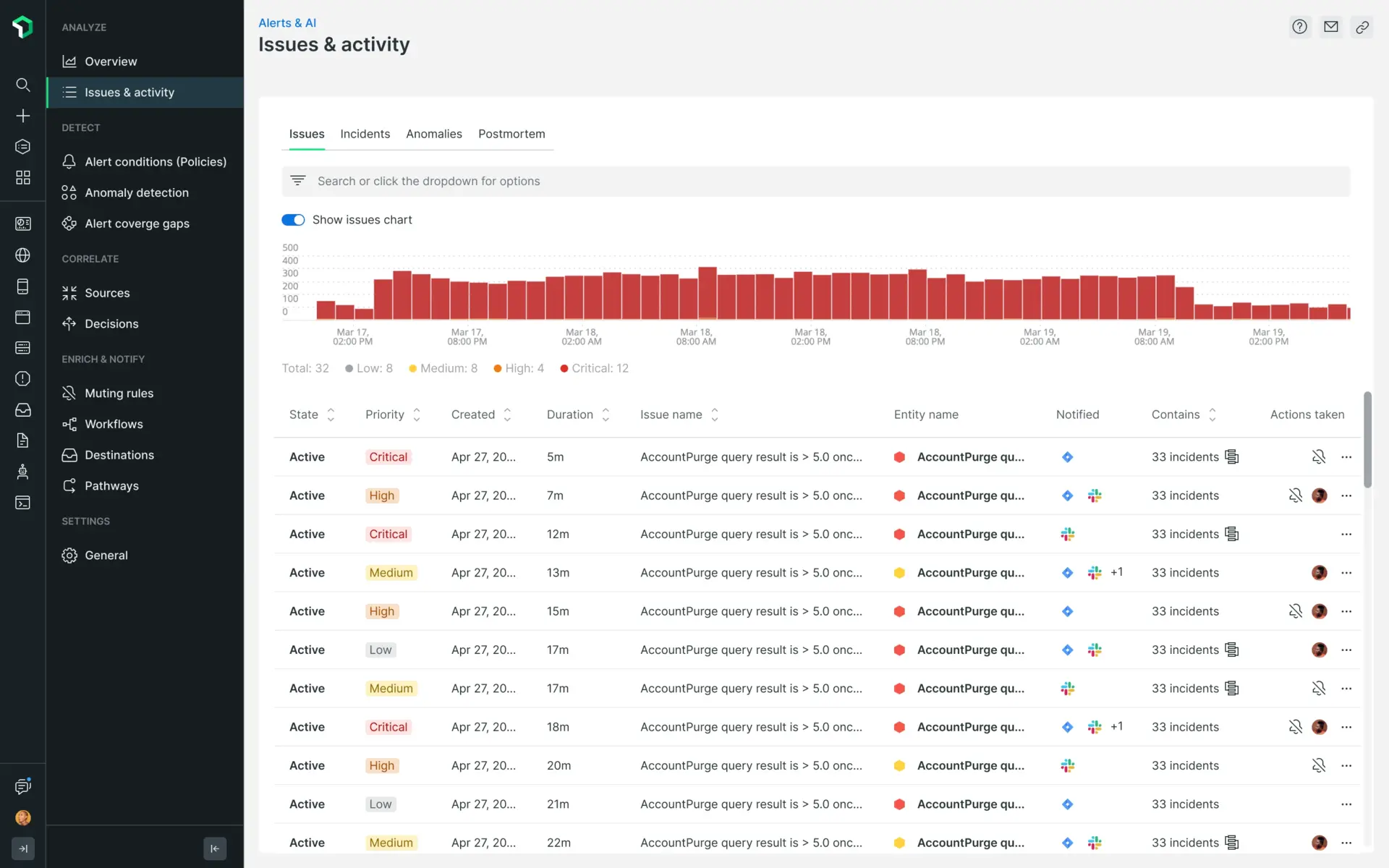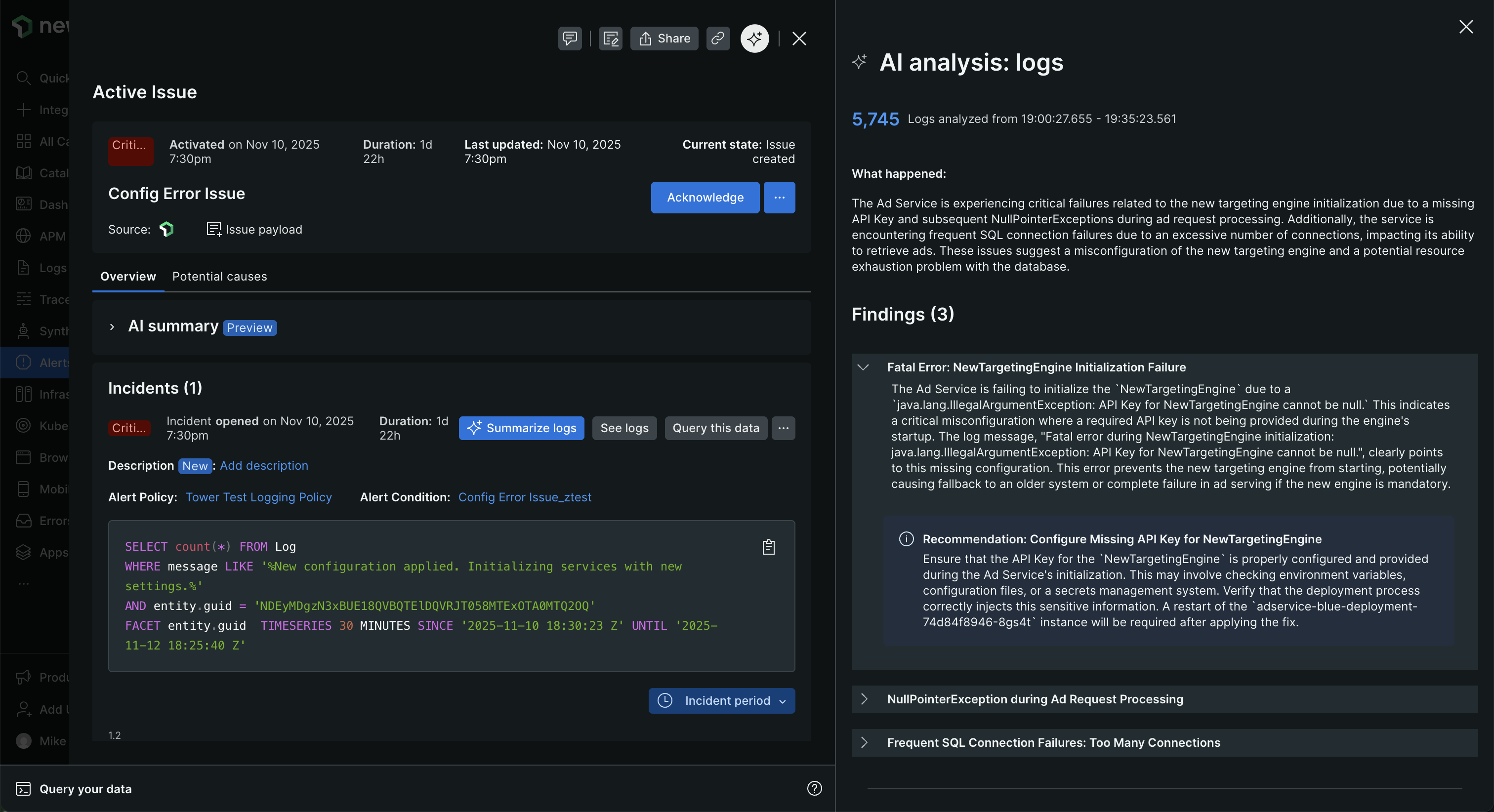이제 뉴렐릭 AI와 통합된 이슈 페이지는 이슈의 평균 해결 시간(MTTR)과 인시던트를 줄이는 데 도움이 되는 동적 인사이트를 제공합니다. 이 기능은 인지도의 주요 세부 정보를 단일 보기로 제공하여 여러 화면을 탐색하지 않고도 문제의 맥락을 빠르게 이해할 수 있도록 해줍니다.

AI 기반 문제 페이지는 영향을 받은 공지, 문제의 심각도, 공지 조건에 대한 설명, 디버깅을 돕기 위한 추가 세부 정보를 포함하는 간결한 요약을 제공합니다. 또한, 문제 페이지에는 새로운 '개요' 탭이 포함되어 있으며, 이 탭에는 응급 대응자가 문제를 처리할 때 묻는 가장 중요한 질문에 대한 답변을 제공하는 세 개의 위젯이 있습니다.

AI 요약 보기
공지 문제에 대한 AI 요약을 보려면:
- one.newrelic.com > Alerts > Issues & activity 으로 이동하세요.
- 공지사항을 선택하세요.
- AI summary 섹션을 확장합니다.
무엇이 영향을 받나요?
응급 대응자는 문제의 심각성을 파악하고 다음 단계를 결정하기 위해 "폭발 반경"을 평가해야 합니다. 이 부분은 해당 부분 또는 서비스의 최종 사용자에게 미치는 영향과 함께 영향을 받은 부분에 대한 개요를 제공합니다.
이전에는 어떤 일이 있었나요?
많은 IT 문제는 계속 반복되는 경향이 있습니다. 문제가 이전에 발생했는지, 왜 발생했는지, 어떻게 해결했는지 아는 것은 응급 대응자가 사건 발생 시 귀중한 시간을 절약할 수 있습니다. 이를 지원하기 위해 고객은 위젯을 사용하여 기존의 회고 또는 사후 분석 문서를 연결할 수 있습니다. 뉴렐릭 AI 플랫폼은 검색 생성(RAG)을 활용하여 향후 상황별 참조를 위해 이 정보를 색인화하고 저장합니다. 구성이 완료되면, 응급 대응자는 유사한 과거 문제에 대한 요약과 자세한 분석을 위한 회고 문서 링크를 볼 수 있습니다.
무엇을 확인해야 하나요?
응급 대응자는 문제를 완화하기 위한 즉각적인 조치에 대한 상황에 맞는 지침이 필요한 경우가 많습니다. 이 위젯은 서비스를 신속하게 정상적인 운영 수준으로 복구하는 데 도움이 되는 맞춤형 단계를 제공합니다. 또한, 잠재적 원인 탭에서는 인과 분석을 통해 가능성 있는 원인을 식별하여 다양한 이상신호 및 성능 문제를 포괄합니다. 자세한 내용은 일반 분석을 참조하세요.
인과 분석
인과 분석 엔진은 공지 이벤트를 발생시켰을 수 있는 잠재적인 증상을 식별하고 이를 해결하기 위한 즉각적인 완화 조치를 제안합니다.
PHP 제작에서 메모리 누수가 발생하여 처리량 SLI에 오류가 발생하고 공지가 트리거되는 시나리오를 생각해 보세요. 저희 엔진은 서비스 수준에서 APM 애플리케이션으로 이동해서 조사를 한 다음, 인프라 컨테이너로 이동하여 증상을 감지합니다.
엔진은 어떻게 작동하나요? 인과 분석 엔진은 구현, 배포 이벤트, 전시 리소스 제한 등과 같은 고유한 분석 범주를 사용합니다. 각 카테고리는 이상신호 및 성능 문제의 다양한 잠재적 원인을 해결하도록 설계되었습니다. 이러한 범주는 특정 데이터 유형과 지표에 초점을 맞추어 정확한 분석과 보다 정확한 인과 관계 식별을 가능하게 합니다.
현재, 뉴렐릭은 APM 농담에 대한 인과 분석만 지원합니다.

완화 조치 및 시각화
식별된 모든 잠재적 원인에 대해 엔진은 사용자가 서비스를 신속히 복구하고 정상적인 작동 상태로 복귀하는 데 필요한 단계를 안내하는 맞춤형 완화 조치를 제공합니다. 많은 고객이 중요한 쿼리를 분석하는 데 NRQL 주로 사용한다는 점을 인지하고, 각 원인에 대한 기본 쿼리와 함께 관련성 있는 시각 자료를 제공합니다.
뉴렐릭 AI 생성 분석
어떤 경우에는 인과 엔진이 알고리즘에 기반한 원인을 식별하지 못할 수도 있습니다. 하지만 LLM과 결합하면 실행 가능한 단계를 제공할 수 있는 인사이트가 있습니다. 이 기능에 액세스하려면 뉴렐릭 AI 권한을 활성화해야 합니다.
로그 기반 알림을 위한 AI 로그 요약
로그 조건에 의해 발생한 공지 문제의 경우, AI 요약은 공지 주변의 맥락적 시간 창에서 최대 100,000개의 로그 항목을 자동으로 검토하여 향상된 분석을 제공합니다. 이 로그 분석은 공지 자체에서는 즉시 눈에 띄지 않는 패턴, 이상 행동, 잠재적인 원인을 표면화합니다.
로그 기반 공지에 대한 AI summary 섹션을 확장하면 다음과 같은 세부 정보를 얻을 수 있습니다.
- Analysis context: 분석된 로그 수, 시간 범위, 모임 이름입니다.
- What happened: 공지 그 자체를 넘어 인사이트와 함께 인시던트를 설명하는 요약입니다.
- Findings (3-4): 특정 수정 단계를 통해 핵심 패턴과 이상 활동을 수행합니다.

자세한 조사 결과를 알아보려면 각 조사 결과를 클릭하세요. AI 요약 섹션 아래에는 다음을 포함한 포괄적인 정보가 표시됩니다.
- 각 결과에 대한 자세한 설명.
- 문제를 해결하기 위한 구체적인 시정 조치입니다.
이 로그별 분석은 수천 개의 로그 항목에서 중요한 정보를 자동으로 표시하여 잠재적 원인을 이해하고 인시던트를 더 빠르게 해결하는 데 도움이 됩니다.